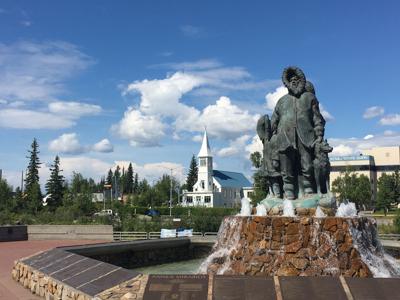• When was Fairbanks founded?
It was incorporated in 1903 but it was actually founded in 1901 when E.T. Barnette set out to establish a trading post at Tanacross on the Tanana River. Low water in the Tanana River forced Barnette to put in a few miles up one of its tributaries, the Chena River. Finding more miners than he expected in the area, Barnette decided to open his trading post here and move to Tanacross the following summer. However, he wound up staying when Felix Pedro discovered gold in the area north of Fairbanks. The city sprouted around Barnette’s trading post. Barnette became the first mayor of the city when it was incorporated in 1903.
• How did Fairbanks get its name?
Fairbanks was named by city founder E.T. Barnette in honor of Sen. Charles W. Fairbanks of Indiana, who would go on to serve as Theodore Roosevelt’s vice president.
• Do people still mine gold in Fairbanks?
Yes, especially with gold prices being what they are. The largest open-pit gold mine in Alaska, Fort Knox Gold Mine, is located 26 miles north of Fairbanks. The Fort Knox mine has produced several million ounces of gold since it opened in 1996. The Pogo Gold Mine, an underground gold mine located 85 miles southeast of Fairbanks, began operation in 2007.
• Is it light all day in the summer?
Look out the window at midnight and you tell us. Seriously, the longest day of the year is summer solstice, which in 2020 is June 20. On that day there will be 21 hours, 49 minutes of official daylight. But it is pretty much light all day long through the first half of July. We start losing six to seven minutes of daylight each day soon after the solstice. In terms of daylight, this day is 18 hours, 8 minutes longer than on December solstice.
• How do you sleep in the summer with all the light?
You close your eyes and count moose. Kidding aside, most people who have spent much time in Fairbanks during the summer either are used to the extended daylight or they get a good set of curtains to keep the light out at night. Beyond that, you can use a mask to cover your eyes or move to the Lower 48.
• Why do people drive around with big, plastic water tanks in the back of their pickup trucks?
Many people in Fairbanks do not have wells because of the high iron and/or arsenic content and instead use holding tanks that are buried beneath the ground and plumbed into the house. Holding tanks for residential homes are usually 1,000 to 1,500 gallons. People with holding tanks have two options: Pay to get water delivered by one of several water delivery companies or haul their own water at a cheaper rate. Those tanks in the back of trucks are for hauling water.
• Can you see the northern lights in the summer?
No. The aurora borealis can be visible in Fairbanks for approximately 200 days a year, roughly from mid-September to April, though they don’t show up every night. The best viewing is usually December through March when it is clearest and coldest.
• Why are there electrical outlets in all the parking lots? And why do people have extension cords sticking out the front of their vehicles?
Due to the extreme cold temperatures in Fairbanks during the winter, most vehicles are equipped with several electric heating devices that facilitate starting during the coldest time. The standard setup consists of an engine block heater, an oil pan heater, and a battery blanket/pad that warms the battery. It usually takes an hour or two after a vehicle is plugged in to warm it enough to start. Most employers provide “plug-ins” for its employees.
• How long does the Chena River stay frozen?
The Chena River usually freezes sometime in mid- to late October and remains frozen until late April or early May. One part of the river, about a mile-long stretch from the Aurora Energy power plant on First Avenue to Pioneer Park, remains open year-round because of the warm water being discharged from the power plant.
• Is it dark all day in the winter?
Not really. The shortest day of the year is Dec. 21, the winter solstice, when there is 3 hours, 43 minutes, of official daylight. But there is usually about a half-hour of twilight on each side of sunrise and sunset that translates to about four or five hours of light during the darkest days, from about 11 a.m. to 4 p.m. Granted, it’s not bright light, but we’ll take what we can get. Soon after Dec. 21, we start gaining six to seven minutes of daylight each day.
• What do people do outdoors in Fairbanks during the winter?
You’d be amazed at how many people you see doing things outdoors in the winter in Fairbanks, even when it’s 20 or 30 degrees below zero. Cross-country skiing, skijoring, dog mushing, snowshoeing, snowmachining — or snowmobiling as people outside Alaska call it — and ice fishing are all popular wintertime activities.
